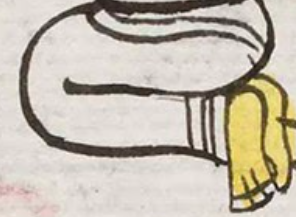tzintli (Mdz13v)
This element has been carved from the compound sign for the place name, Nantzintlan. It is the lower half (tzintli) of a seated woman. Her skirt, which reaches down to just above her bare feet, is white. She is sitting upright, and she is facing toward the viewer's left, in profile.
Stephanie Wood
Normally, the bottom half of a male is provided for tzintli. Here it is a female to help cover the meaning of mother (nantli). As with all—or at least the vast majority—of examples of this glyph, the meaning "buttocks" has nothing to do with the meaning of the glyphs, although it may have a metaphorical value of "lower." When modifying a place name, as Frances Karttunen suggests, the meaning of "tzin" is new, little, or lower. It can also refer to something revered, for instance, when combined with something having the element "teo" (from teotl, divine force). Here, the -tzin element is possibly a reverential for mother.
Stephanie Wood
c. 1541, but by 1553 at the latest
Stephanie Wood
bottoms, mothers, woman, women, butts, buttocks, rear end, little, lower, nalgas, trasero

tzin(tli), buttocks, https://nahuatl.wired-humanities.org/content/tzintli
-tzin, new, little, lower, or reverential, https://nahuatl.wired-humanities.org/content/tzin
buttocks, diminutive, or reverential
las nalgas, el ano; diminutivo o reverencial
Stephanie Wood
Codex Mendoza, folio 13 verso, https://digital.bodleian.ox.ac.uk/objects/2fea788e-2aa2-4f08-b6d9-648c00..., image 37 of 188.
The Bodleian Libraries, University of Oxford, hold the original manuscript, the MS. Arch. Selden. A. 1. This image is published here under the UK Creative Commons, “Attribution-NonCommercial-ShareAlike 3.0 License” (CC-BY-NC-SA 3.0).


